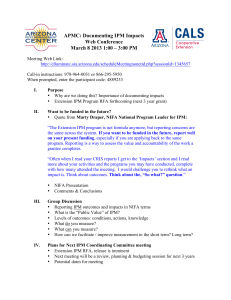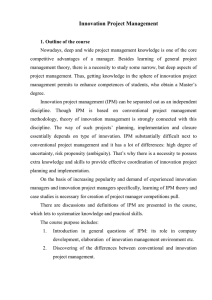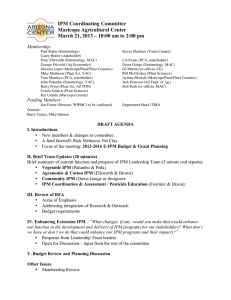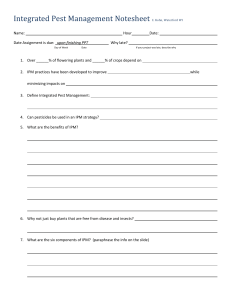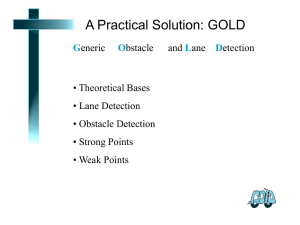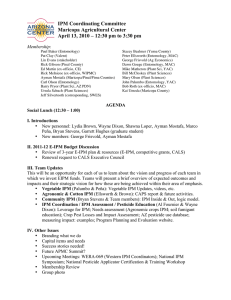IPM Coordinating Committee Maricopa Agricultural Center
advertisement
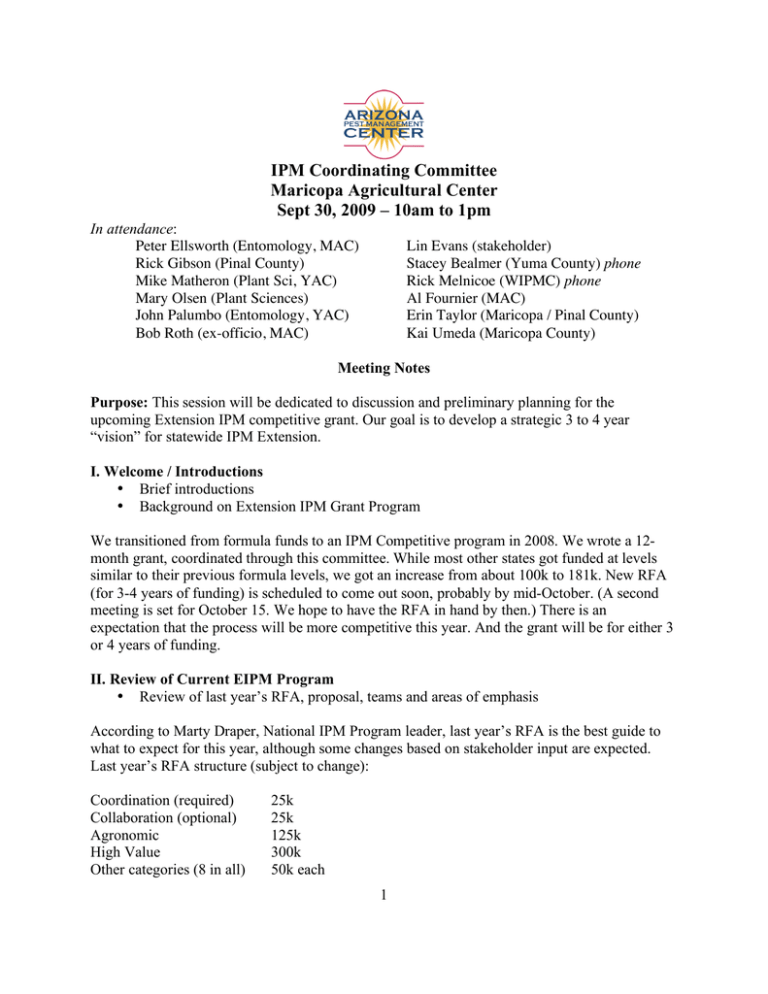
IPM Coordinating Committee Maricopa Agricultural Center Sept 30, 2009 – 10am to 1pm In attendance: Peter Ellsworth (Entomology, MAC) Rick Gibson (Pinal County) Mike Matheron (Plant Sci, YAC) Mary Olsen (Plant Sciences) John Palumbo (Entomology, YAC) Bob Roth (ex-officio, MAC) Lin Evans (stakeholder) Stacey Bealmer (Yuma County) phone Rick Melnicoe (WIPMC) phone Al Fournier (MAC) Erin Taylor (Maricopa / Pinal County) Kai Umeda (Maricopa County) Meeting Notes Purpose: This session will be dedicated to discussion and preliminary planning for the upcoming Extension IPM competitive grant. Our goal is to develop a strategic 3 to 4 year “vision” for statewide IPM Extension. I. Welcome / Introductions • Brief introductions • Background on Extension IPM Grant Program We transitioned from formula funds to an IPM Competitive program in 2008. We wrote a 12month grant, coordinated through this committee. While most other states got funded at levels similar to their previous formula levels, we got an increase from about 100k to 181k. New RFA (for 3-4 years of funding) is scheduled to come out soon, probably by mid-October. (A second meeting is set for October 15. We hope to have the RFA in hand by then.) There is an expectation that the process will be more competitive this year. And the grant will be for either 3 or 4 years of funding. II. Review of Current EIPM Program • Review of last year’s RFA, proposal, teams and areas of emphasis According to Marty Draper, National IPM Program leader, last year’s RFA is the best guide to what to expect for this year, although some changes based on stakeholder input are expected. Last year’s RFA structure (subject to change): Coordination (required) Collaboration (optional) Agronomic High Value Other categories (8 in all) 25k 25k 125k 300k 50k each 1 There was $625 cap overall. States were required to apply for “coordination” plus at least 2 areas of emphasis. We applied for the maximum of 6 areas of emphasis, plus coordination and collaboration. We were funded at much lower levels than requested and some areas of emphasis were “zeroed out” by the review panel. We shifted funds around (which is allowed, see “modified” column below) and folded in some carryover funds to provide minimal support to the unfunded areas of emphasis. Funds were shifted to reflect PI access to subaccounts. For example, “Coordination” includes partial salary funds for Al, Richard Farmer (database specialist) and Theresa Smith (web specialist). But the efforts of personnel covered by these funds are heavily invested other areas of emphasis, particularly Agronomic IPM, High Value IPM, and Collaboration. Category Coordination Collaboration Agronomic High Value School IPM Turf IPM Diagnostics Urban IPM-MG Requested 25,000 25,000 26,812 244,610 49,670 41,721 41,978 20,000 494,792 Funded 25,000 25,000 15,000 100,000 0 0 0 16,000 181,000 Modified 94,286 9,000 8,700 61,014 4,000 3,000 5,000 16,000 200,999 PI Fournier minigrants Gibson Ellsworth/Palumbo/McClosk Gouge Umeda Olsen & Olson Schuch II. Strategic Thinking Discussion Last year it was a challenge to meet the page limits because we had so many emphasis areas. Suggestion: fold some of our activities into fewer emphasis areas, e.g., some funds for diagnostics across several areas. Similarly, maybe we could lump school IPM, turf and urban into a single area. There may be a disadvantage to doing this if the program maintains funding caps for the various emphasis areas. A basic question is what should we focus on. This year, we are doing an agronomic IPM needs assessment. We will need to look at the data to determine if this is a viable area to apply for in the next RFA. Without having seen the RFA, we need to have a broader discussion about what we want to do and what we need to invest in: • New human resources versus existing programs and people. New hires could include specialists, agents, technicians, post docs, or assistants in extension (not part of retention system) that would work directly with specialists. John is looking to hire an assistant in extension in Yuma through our current one year of funding. • The university is currently doing hiring through “initiatives”, not through departments. Recently, they offered 3 years of 50% funding for positions for successful proposals submitted by departments. We could potentially leverage something through the IPM funds, and approach the Dean to request the balance of resources. 2 A review of what we asked for in first year of IPM funding: Assistants in Extension (< 3 FTE) • Veggie IPM – support for publications, coordination, writing • Cotton IPM – support for demonstrations & grower trials / experimentation • Tree IPM – a fraction of a person Technical Support This category was requests for salary to support either existing or to-be-hired technician-level or postdoc positions. • MG programming • Diagnostics • School IPM • Turf IPM – developing research base for new programs in turf Things • High-end microscope in Yuma • Travel Our next request does not have to be constrained by what we did before. The Master Gardener program is in flux. The question arose, can MG be coordinated and used as a statewide IPM resource? Rob Call is the new statewide coordinator. Tucson has a strong program (Rob Call working with local volunteer coordinator). Maricopa County volunteers are working hard. But we are suffering statewide as far as coordination of these efforts. Rick and Erin are starting to see a new clientele group, people filling a niche for direct farm markets, as a commercial enterprise. IPM is an important component of what they need to learn. In the future this may be a major focal area for MGs, to take pressure off those of us who are supporting commercial agriculture needs. The turf group is similar: only part of what they do is IPM-related, and the group is not always fully functional. Diagnostics gets no state support; Mary and Mike have gotten some PDN funds, but the management of those resources is not transparent. We discussed the possibility of initiating a dialog with the PDN group about investing most of their funds into a diagnostician position that we could co-support through IPM funds. A key question in all this is: What makes UA /CALS relevant to clientele? They want service, e.g., diagnostics, and applied research that produces accurate, practical, user-friendly information. 3 In the next proposal, we should emphasize the research aspect of what we do and why it is important, as well as “service.” Maybe find another word for “research.” Our strengths are in vegetable and cotton IPM programs. It would be great to have an Assistant in Extension that could help with writing, paperwork, web posting, etc. Also emphasize how well we leverage our limited funding. Please be thinking more on IPM needs and how best to approach this call. III. Other Issues • WEDA Award for UA IPM Program. The UA IPM Program was awarded Honorable Mention in the Western Extension Director’s Award of Excellence. Award certificates were made out to all IPM Coordinating Committee members, and were distributed to those present at the meeting. • Pesticide Safety Education Program update. Peter Ellsworth was recently appointed Pesticide Coordinator by Jim Christenson. This is a federal designation and means Peter is responsible for the statewide Pesticide Safety Education Program. He represented our programs this year at the annual national meeting in Charleston, SC, where he presented information on the 1080 database and Crop Pest Losses data for evaluation of IPM programs. Fund received this year, about $24,000, were distributed by the IPM CC in minigrants to faculty. This has resulted in a number of pesticide safety trainings throughout the state. We have heard very positive feedback from agents and clientele on this new system. This year, a new National CORE exam has been adopted in Arizona. At a recent Flagstaff training, 16 out of 17 people taking the exam passed it, a much higher percentage than in past years. • Extension publication review process update. The new system for reviewing IPM related Extension publications online is in place. Peter and Al are serving as editors. So far, we have had 8 publications submitted by faculty, one is still in process, 6 were accepted with various levels of revision, and one was rejected and later resubmitted and accepted after substantial revisions. • Budget Update. This year accounting was challenging because we were managing carryover formula funds and new EIPM funds on two different systems. We have spent the remaining carryover funds which expire this week. Please note that we have some flexibility with the new EIPM funds. If funds designated for one PI or area of emphasis are more than are needed, funds can be shifted or saved as carryover funds. We already have about $31,000 extra in the EIPM master account because this is what PIs with new IPM funding were able to spend in carryover funds. • Next meeting is scheduled for October 15 at MAC at 10 AM. However, if it looks like the RFA may not be released by then, we may try to schedule an alternate, later meeting date. 4
